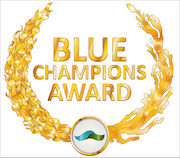May until Juli 2013: Issues after the major rain period
24.07.2013
Due to heavy algae cover growth of the black sponges was marginal during the three-monthly rainy season and the loss is much higher than expected. As a consequence, we feel impelled to drop our plan to start production with the black sponges this year. The situation seems to be the worst in Mtende despite the fact that the black sponges are naturally abundant in this area. A decision whether a sustainable cultivation of this species is viable or not will be made by the end of the year (after finalisation of our cultivation tests).
Spongefarm in Mtende: Empty ropes with juvenile Roundface Batfish
The grey species, which we cultivate in the small farm in Jambiani, has also suffered during this period. In this case we are dealing with a disease infestation. If only a part of a sponge is compromised, the animal may be saved by cutting the infested part off. Completely infested sponges, however, can not be saved.
A seaweed disease wiping out almost 90% of cultivated seaweed has appeared at the same time. The cultivation of seaweed has been given up by most seaweed farmer, at least for the time being. According to an expert with the IMS the seaweed disease is a bacterial infection known as „Ice-Ice“ which may be attributed to changing environmental conditions. (http://en.wikipedia.org/wiki/Ice-ice).
Disease in the small farm: Left – infested sponge, right – healthy sponge
(Addition December 2013: The seaweed has barely recovered and the loss of income is especially for poorer families a major issue. The development of alternative means of income, especially for women, is urgent in this grave situation.)




